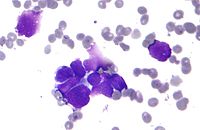
Photo from wikipedia
Bone tissue attracts cancer cell homing biologically, mechanically, or chemically. It is difficult and time consuming to identify their complex cross-talk using existed methods. In this study, a multi-component bone… Click to show full abstract
Bone tissue attracts cancer cell homing biologically, mechanically, or chemically. It is difficult and time consuming to identify their complex cross-talk using existed methods. In this study, a multi-component bone matrix was fabricated using gelatin, hydroxyapatite (HAp), and epidermal growth factor (EGF) as raw materials to investigate how “acellular” bone matrix affects cancer cell homing in bone. Then, EGF-responsive cancer cells were cultured with the scaffold in a dynamical bioreactor. For different culture periods, the effects of HAp, gelatin, and EGF on the cell adhesion, proliferation, 3D growth, and migration of cancer were evaluated. The results indicated that a small amount of calcium ion released from the scaffolds accelerated cancer MDA-MB-231 adhesion on the surface of inner pores. Moreover, degradable gelatin key caused cancer cell growth on the scaffold surface to turn into a 3D aggregation. Despite this, the formation of cancer spheroids was slow, and required 14 days of dynamic culture. Thankfully, EGF promoted cancer cell adhesion, proliferation, and migration, and cancer spheroids were observed only after 3-day culture. We concluded that the combination of the multiple components in this scaffold allows cancer cells to meet multiple requirements of cancer dynamic progression.
Journal Title: Polymers
Year Published: 2022
Link to full text (if available)
Share on Social Media: Sign Up to like & get
recommendations!